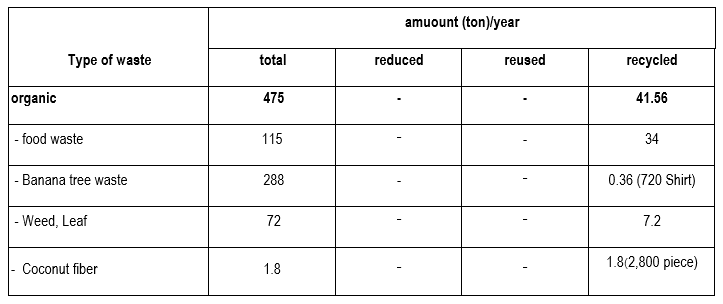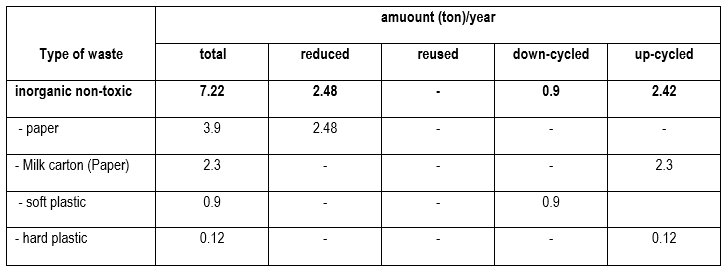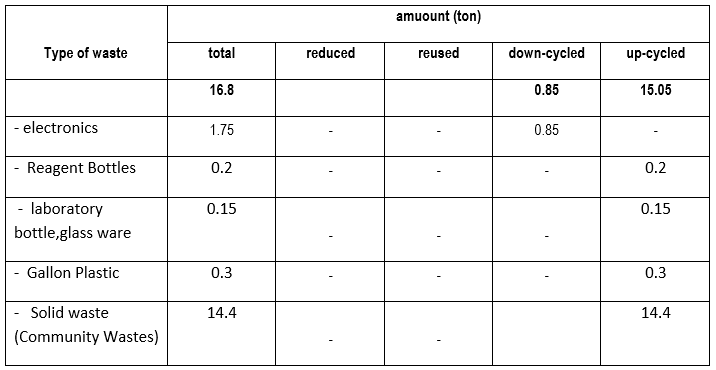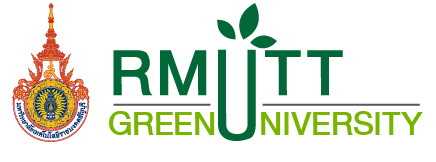Total volume organic waste treated

The table indicates the total amount of organic waste on campus and how much of it was recycled in tons. It can be seen that the waste from banana trees is the biggest of all, followed by food waste, weed and leaf, and then coconut fiber. The university put an effort to take advantage of these wastes in the following ways:
Food waste: The system settings or infection settings cultivated microorganisms ready to be used for decomposition. The system produced fertilizer from fermented microorganisms present in organic waste by using a bio-digester (Macronutrient content: total nitrogen (3.6%), phosphorus (2.3%) and potassium (2.4%), organic matter (70%), C/N (11:1)). Six hundred kg of biomass waste was decomposed per day and produced 60 kg of bio-fertilizer a day or 115 tons/year. The products are primarily for self-consumption on farms.
Banana tree waste: Associate Professor Dr. Sakorn Cholasakorn, Dean of the Faculty of Home Economics at Rajamangala University of Technology Thanyaburi and Natural fiber research professor has conducted a project for fabrics from plant fibers. This project aims to use agricultural waste from banana fibers to produce beautiful fabrics. Waste from bananas at 288 tons can be changed into 720 shirts per year on average, which helps reduce the burden of waste as well.
Weed and leaf: Employees of Rajamangala University of Technology Thanyaburi have performed to dispose of organic waste by allowing natural degradation and then reusing it on campus. Organic waste was collected at 6,000 kg/month and bio-fertilizer was produced at 500-600 kg/month.
Coconut fiber: The project aims to create biodegradable pots from chopped coconut husks. The organic waste was collected at 150 kg/month.
Total volume inorganic waste treated

The table indicates the total amount of inorganic waste on campus in tons. It can be seen that waste from paper has the biggest amount among all types, followed by soft plastic, and then hard plastic. The university put an effort to take advantage of these wastes in the following ways:
Paper : Previously, the university had internal communications using a document system. Resulting in the use of approximately 3.9 tons of paper. Later, the university developed an electronic document delivery system (E-office) which was able to reduce the use of paper by 2.48 tons.
Milk carton (Paper): The university has conducted and developed a continuous recycling project of university waste for new hopes of the Rajamangala University of Technology Thanyaburi under a theme “Smart people help society more”, using 20 kg. per 1 roof sheet (size 1.2×2.4 m.) to collect 2,300 kg. of waste which resulted in 115 roofing sheets.
Soft plastic: Rajamangala University of Technology Thanyaburi has a waste recycling bank in student dormitory area which can provide a service without staff. This allows students to earn income from recycled waste. On Average, around 2,500 bottles of recycled waste are collected per month
Hard plastic: Asst. Prof. Dr. Narongchai Ocharoen, a lecturer at the Faculty of Engineering, has conducted a project aimed to form products from plastic waste collected in the area of Rajamangala University of Technology Thanyaburi.
Total volume toxic waste treated

Description: This program aims to dispose of toxic waste which is then handled by specialists, organized by the Department of Science and Technology, the Rajamangala University of Technology Thanyaburi.
Additional evidence link (i.e., for videos, more images, or other files that are not included in this file) packaging back to use again. By wiping and cleaning the chemicals inside the package thoroughly before sending it for recycling
